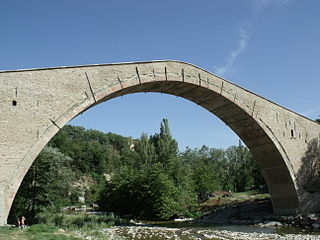
Imola is a city and comune in the Metropolitan City of Bologna, located on the river Santerno, in the Emilia-Romagna region of northern Italy. The city is traditionally considered the western entrance to the historical region Romagna.

The Autodromo Internazionale Enzo e Dino Ferrari, better known as Imola, is a 4.909 km (3.050 mi) motor racing circuit in the town of Imola, in the Emilia-Romagna region of Italy, 40 km (25 mi) east of Bologna. It is one of the few major international circuits to run in an anti-clockwise direction. The circuit is named after Ferrari's late founder, Enzo Ferrari, and his son, Alfredo "Dino" Ferrari, who died on 30 June 1956, at age 24, of Duchenne muscular dystrophy. Before Enzo's death, it was called Autodromo Dino Ferrari. The circuit has an FIA Grade One licence.

Francesco Alidosi was an Italian cardinal and condottiero. He accompanied Giuliano della Rovere to France in 1494, and continued in favor when Della Rovere was elected pope, becoming Pope Julius II. Alidosi was elected as bishop of Mileto in 1504, and then transferred to the see of Pavia on 26 March 1505. He occupied the seat until his death in 1511.

The Wars in Lombardy were a series of conflicts between the Republic of Venice and the Duchy of Milan and their respective allies, fought in four campaigns in a struggle for hegemony in Northern Italy that ravaged the economy of Lombardy and weakened the power of Venice. They lasted from 1423 until the signing of the Treaty of Lodi in 1454. During their course, the political structure of Italy was transformed: out of a competitive congeries of communes and city-states emerged the five major Italian territorial powers that would make up the map of Italy for the remainder of the 15th century and the beginning of the Italian Wars at the turn of the 16th century. They were Venice, Milan, Florence, the Papal States and Naples. Important cultural centers of Tuscany and Northern Italy—Siena, Pisa, Urbino, Mantua, Ferrara—became politically marginalized.

The Roman Catholic Diocese of Imola is a territory in Romagna, northern Italy. It is a suffragan of the Archdiocese of Bologna. The diocese had originally been a suffragan of the metropolitan of Milan, and was then subject to the Archbishop of Ravenna until 1582, when Pope Gregory XIII made Bologna an archbishopric and assigned it two suffragans, Imola and Cervia. In 1604, however, Pope Clement VIII returned them to the metropolitanate of Ravenna. Pope Pius VII transferred Imola back to the metropolitanate of Bologna.
Borgo Tossignano is a comune (municipality) in the Province of Bologna in the Italian region Emilia-Romagna, located about 30 km (19 mi) southeast of Bologna.

Castel del Rio is a comune (municipality) in the Metropolitan City of Bologna in the Italian region Emilia-Romagna, located about 35 kilometres (22 mi) southwest of Bologna.
Giorgio Ordelaffi was lord of Forlì and Papal vicar in Romagna. He was a member of the Ordelaffi family.
Teobaldo II Ordelaffi was briefly lord of Forlì from 1422 to 1424. He was the son of Giorgio Ordelaffi.
Luigi Alidosi was the lord of Imola from 1391 until 1424, the last ruler of the city from his family. He was the son of Bertrando Alidosi.
Benvenuto Rambaldi da Imola, or simply and perhaps more accurately Benvenuto da Imola, was an Italian scholar and historian, a lecturer at Bologna. He is now best known for his commentary on Dante's Divine Comedy.

The Alidosi or Alodosi are a family of Romagna, Italy, who held the signoria of the city of Imola during the Late Middle Ages. They were originary of the Santerno valley.

The Santerno is a river in Romagna in northern Italy. It is a major tributary of the river Reno. In Roman times, it was known as the Vatrenus, although, in the Tabula Peutingeriana, it was already identified as the Santernus.
Roberto Alidosi was a lord of Imola in the 14th century.
Lippo I Alidosi was the de facto lord of Imola, northern Italy, in 1278–1288, as captain of the people and Defensor Pupuli Imole et Capitaneus Civitatis Imole.
Lippo is an Italian historical male name and it represents a diminutive of Filippo. It may refer to:
Bertrando Alidosi was an Italian condottiero and the lord of Imola from 1372 until 1391. He was the son of Roberto Alidosi, and succeeded in his signoria to Azzo Alidosi, to whom he had been associated by will of Pope Urban V. In 1365 he had been also made lord of Castel del Rio, Monte del Fine and Castiglione. The two brothers were jailed in Bologna two times by the papal forces, but they were permitted to return soon to Imola. In 1371 he was forced by a rebellion to flee shortly at Avignon with Pope Gregory XI.
Esteban Gabriel Merino was a Spanish Roman Catholic bishop and cardinal.

Cianghella della Tosa lived in late medieval Florence, Italy. She was born into the Florentine Della Tosa family and married into the Alidosi family of Imola, near Bologna. Most of what is known about Cianghella is due to her reference in Dante's Divine Comedy.

The 2022 Emilia Romagna Grand Prix was a Formula One motor race held on 24 April 2022 at the Autodromo Internazionale Enzo e Dino Ferrari in Imola, Italy. It was the first Grand Prix weekend of the 2022 season to utilize the Formula One sprint racing format.








